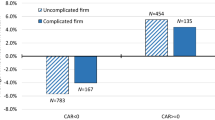Abstract
We examine the effect of corporate diversification by comparing abnormal returns between portfolios of diversified firms and focused firms. Our study covers US firms for the years 1976–2009 and compares abnormal returns over 12, 24, and 36-month windows. Initial univariate tests show mixed results, though after we control for firm, industry, and time effects, we find convincing evidence that diversified-firm portfolios outperform focused-firm portfolios over the 3-year term. Our findings indicate that the benefits of corporate diversification are captured over longer investing horizons.
Similar content being viewed by others
Notes
Fama and French have grouped several firm industries by four-digit SIC code. The groupings range from a five-industry set, up to a 49 industry set. Berger and Ofek (1995) and Santalo and Becerra (2008) use a two-digit SIC industry indicator, classifying up to 100 different industries. The Fama and French industries have a distinct advantage over the narrower two-digit industry class, as the number of firms per industry does not allow for a few firms to dominate the industry return. Moreover, both Berger and Santalo eliminate industries that have fewer than five single-segment firms.
References
Amihud, Yakov. 2002. Illiquidity and stock returns: Cross-section and time-series effects. Journal of Financial Markets 5: 31–56.
Berger, Philip G., and Eli Ofek. 1995. Diversification’s effect on firm value. Journal of Financial Economics 37: 39–65.
Berger, Philip G., and Eli Ofek. 1999. Causes and effects of corporate refocusing programs. The Review of Financial Studies 12: 311–345.
Billett, Matthew T., and David C. Mauer. 2000. Diversification and the value of internal capital markets: The case of tracking stock. Journal of Banking & Finance 24: 1457–1490.
Bradley, Michael, Anand Desai, and E. Han Kim. 1988. Synergistic gains from corporate acquisitions and their division between the stockholders of target and acquiring firms. Journal of Financial Economics 21: 3–40.
Chang, Yuk Ying, Sudipto Dasgupta, and Gilles Hilary. 2010. Ceo ability, pay, and firm performance. Management Science 56: 1633–1652.
Desai, Hemang, and Prem C. Jain. 1999. Firm performance and focus: Long-run stock market performance following spinoffs. Journal of Financial Economics 54: 75–101.
Dong, Ming, Igor Loncarski, Jenke ter Horst, and Chris Veld. 2012. What drives security issuance decisions: Market timing, pecking order, or both? Financial Management 41: 637–663.
Farber, David B. 2005. Restoring trust after fraud: Does corporate governance matter? Accounting Review 80: 539–561.
Hyland, David C., and J.David Diltz. 2002. Why firms diversify: An empirical examination. Financial Management 31: 51–81.
Jensen, Michael, and Richard Ruback. 1983. The market for corporate control* 1: The scientific evidence. Journal of Financial Economics 11: 5.
Kruse, Timothy A., Hun Y. Park, Kwangwoo Park, and Kazunori Suzuki. 2007. Long-term performance following mergers of Japanese companies: The effect of diversification and affiliation. Pacific-Basin Finance Journal 15: 154–172.
Lang, Larry H.P., and René M. Stulz. 1994. Tobin’s q, corporate diversification, and firm performance. Journal of Political Economy 102: 1248.
Liebenberg, Andre P., and David W. Sommer. 2008. Effects of corporate diversification: Evidence from the property–liability insurance industry. Journal of Risk & Insurance 75: 893–919.
Lins, Karl, and Henri Servaes. 1999. International evidence on the value of corporate diversification. The Journal of Finance 54: 2215–2239.
Lu, Jane W., and Paul W. Beamish. 2004. International diversification and firm performance: The s-curve hypothesis. Academy of Management Journal 47: 598–609.
Minnick, Kristina, Haluk Unal, and Liu Yang. 2011. Pay for performance? Ceo compensation and acquirer returns in bhcs. The Review of Financial Studies 24: 439–472.
Santalo, Juan, and Manuel Becerra. 2008. Competition from specialized firms and the diversification-performance linkage. The Journal of Finance 63: 851–883.
Servaes, Henri. 1996. The value of diversification during the conglomerate merger wave. Journal of Finance 51: 1201–1225.
Author information
Authors and Affiliations
Corresponding author
Rights and permissions
About this article
Cite this article
Lawrey, C.M., Morris, B.C.L. Corporate diversification and abnormal returns. J Asset Manag 20, 31–37 (2019). https://doi.org/10.1057/s41260-018-0100-0
Revised:
Published:
Issue Date:
DOI: https://doi.org/10.1057/s41260-018-0100-0




